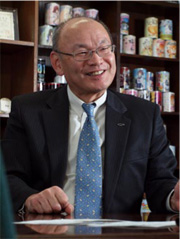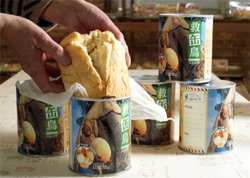Home > Highlighting JAPAN > Highlighting Japan FEBRUARY 2011 > Breakthroughs in Bakery
Highlighting JAPAN
MONODZUKURI
Breakthroughs in Bakery
Can you name a Japanese product that has earned the gratitude of thousands of victims of major earthquakes in Haiti and Sri Lanka, and that was also taken into space on the Space Shuttle? Miho Yanagisawa introduces the product developed by Pan Akimoto.

Pan Akimoto President Yoshihiko Akimoto
Credit: TADASHI AIZAWA
The canned bread was developed by Pan Akimoto, a bakery located in Nasushiobara, Tochigi Prefecture. This local bakery started to make canned bread following the Great Hanshin-Awaji Earthquake, which struck on January 17, 1995. The magnitude 7.3 earthquake killed more than 6,000 people and left more than 40,000 injured.
Hearing about this tragedy, the current president Yoshihiko Akimoto and his predecessor, Kenji Akimoto, thought that as bakers they ought to be providing bread for the victims. They trucked in more than 2,000 loaves while roads and transportation facilities were yet to be restored. The long journey from Tochigi took them one and a half days. However, some of the bread had passed its use-by date before it was delivered to the victims, and was consequently discarded. An acquaintance of Yoshihiko, who later told him about the wasted bread, asked him, "Couldn't you make soft bread that would keep well like kanpan (a sea biscuit)?"
"That's impossible," was Akimoto's first answer. The soft texture of bread and preservative qualities conflict with each other, and are impossible to combine.
"Kanpan and ordinary soft pan (bread) are completely different products, although their names sound similar. Nevertheless, between my regular tasks, I started to experiment with production."
With advice from a professor at a university agricultural department, Akimoto tried to create a material composition that would reduce the deterioration of the bread dough, or the deterioration of the starch contained within it. He also came up with a method of baking bread after putting it into a can, which keeps it sterile. He also succeeded in preventing deterioration caused by oxidization by putting a deoxidizer into the can and closing its lid in a sterilized room. A technique for retaining a good taste is to keep the bread wrapped with ovenproof paper while baking it. By using this method, Yoshihiko succeeded in preventing the bread from being dried out. And so, after nearly one year of trial and error, he had developed canned bread.
The canned bread earned an excellent reputation after it was used as relief supplies for victims of Japan's Niigata Chuetsu Earthquake that struck in 2004 and for victims of the earthquake in the Indian Ocean off Sumatra that occurred at the end of that same year.

Pan Akimoto's Ever Fresh Bread has a shelf life of three years.
Credit: TADASHI AIZAWA
Canned Bread Crosses Borders
In 2007, when canned bread was being widely used as an emergency food by many companies and local governments, Akimoto came up with an idea of reusing it. He started to trade in canned bread that would expire within a specific time. He sends letters to purchasers of the bread, including schools, companies, and local governments, collects products that will expire in one year, and sells them new canned bread at a trade-in price. The collected bread is then sent to areas suffering from food shortages as relief supplies by NGOs working to save people from hunger. Buying back the canned bread allows purchasers to buy new products at lower prices and to make an international contribution as well.
Full-scale operation of the project began in 2009. So far more than 30,000 cans have been sent overseas thanks to the support of around 2,000 individuals, local government bodies and private companies.
"Canned bread is intended for use in emergencies such as disasters, so the best thing is not to have to open it. However, because I am a baker, I want the bread to be enjoyed by people rather than being thrown away."
Akimoto's father, Kenji, was an air force pilot during World War II. He was ashamed of having participated in the war and wanted to contribute to the world. The wish of the father is now being taken on by his son.
In 2009, the canned bread not only crossed borders, it left the Earth entirely. After passing the NASA test, which requires "200% safety," it was included on the Space Shuttle Discovery as space food when Japanese astronaut Wakata Kouichi stayed at the International Space Station.
"I felt very motivated, because that is unprecedented," says Akimoto. As he continues to take on new challenges, that motivating force is his passion.
| Business name: | Pan Akimoto Co., Ltd. |
| Representative: | Yoshihiko Akimoto |
| Capital: | 35 million yen |
| Number of employees: | 45 |
| Address: | 295-4 Higashigoya, Nasushiobara-shi, Tochigi, Japan |
© 2009 Cabinet Office, Government of Japan






